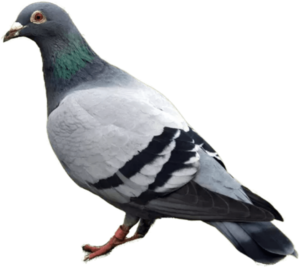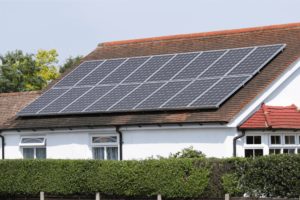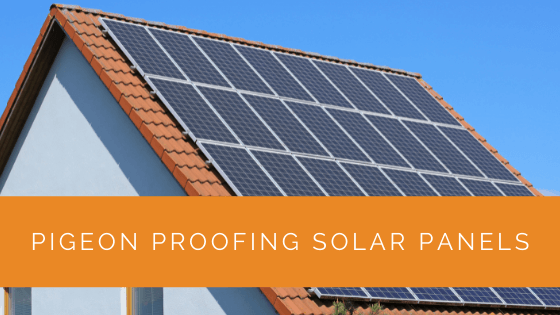UK residents are increasingly choosing solar panels as an excellent option for sustainable energy. But some infamous pesky birds have also discovered them to be a potential home.
You’ve guessed it right – we’re referring to pigeons and how they can be a pest for solar-installed premises. Pigeons and other birds usually rest on rooftops and can easily ruin the panel setup if not taken care of.
You may have already set up an array, or the process may be in the pipeline. No matter the stage, it would be best to consider some practicalities around fitting your solar panels.
There are many strategies to keep away birds; not all will fit your house design. So, a good idea would be to research and ask what your fellow solar panel neighbours have done on their rooftops.
To further help you with it, we’ve put together a handy guide to ensure your solar panels function well for years to come.
Before diving into the suggestions to proof your panels, you must know how pigeons damage them and add extra costs to your pocket.
Contents
- 1 Key Takeaways
- 2 How Do Pigeons Damage Your Solar Panelling?
- 3 9 Pigeon Proofing Ideas for Solar Panels
- 4 How Much Would It Cost?
- 5 Case Study: Effective Pigeon Proofing for Solar Panel Systems
- 6 Expert Insights From Our Solar Panel Installers About Pigeon Proofing Solar Panels
- 7 Discover the Power of Solar with Solar Panels Network
Key Takeaways
- Pigeons can pose problems for solar panel installations, causing reduced power efficiency, damage to panels and roofs, and attracting other pests.
- Nine pigeon-proofing strategies for solar panels include cleaning panels regularly, using roof spikes, keeping gardens and bins clean, installing guards and nets, using deterrents like plastic birds, employing sloped coverings, and utilizing supersonic noise generators.
- The cost of pigeon-proofing varies depending on factors like self-installation or professional help, the number of panels, and the level of damage, with costs starting at around £300.
How Do Pigeons Damage Your Solar Panelling?
Reduced Power Efficiency
Your panel’s performance can take a hit if pigeons are nesting underneath. Pigeons commonly build nests as it is a safe place from predators. Solar panels are often warm, and birds like the heat for their shelter.
With a lot of pigeons comes even more pigeon droppings. This collectively blocks sunlight on the panels and reduces the total power output.
Damaged Panels and Roofs
The big problem with nesting is that pigeon waste is acidic and corroding roof surfaces. This damages the solar panels and floors, and resting pigeons also stain the roof and cause leaks. They also increase the chances of other pests settling between the panels.
When pigeons build nests under the solar panels, your roofs may face water-logging when it rains. Stagnant water in corners attracts more pests like flies, increasing your troubles.
Other Pests
Another disadvantage of hovering pigeons is that their nests under solar panels may invite other pests like squirrels and rodents. The electrical wiring of the place may be at risk as they can chew on them. This is dangerous as it can lead to short circuits and, in extreme cases, fires.
All these issues sound worrying. Investing in pigeon-proof setups to avoid messy roofs and longer damage is the key to avoiding such troubles.

9 Pigeon Proofing Ideas for Solar Panels
You can opt for these common tips to pigeon-proof your solar panels and avoid the mess they can create.
1. Clean the Panels Regularly
This one’s probably the most inexpensive option from the lot. You can avoid birds and other pests from the solar panels by keeping them clean with regular maintenance. Remember to be gentle on the panels and wipe gently as they are fragile.
Agreed, it may seem like a lot of work, and it won’t be much help if you’ve got a persistent problem of pigeons.
2. Lace Roof Spikes
This is quite an aggressive option, but spikes make roosting difficult and keep obstinate pigeons at bay. As it gets uncomfortable to hop around, they will ideally not prefer staying longer and fly away.
You may wonder if spikes appear unattractive, but they are among the most efficient ways to protect panels. We’d recommend getting high-quality spikes that don’t rust with time.
3. Clean up Your Garden
Pigeons frequent untidy places, and your open garden is an easy target. As a proactive measure, keep your open spaces clean. Make sure there’s no waste lying around for them to feed on.
4. Clear Your Bins
As an extension of the above tip, keeping your bins free of food waste is a good step. It would be best to clear out anything birds might eat around your garden for this method to be effective. Replace any open dustbins with closed lids to avoid litter.
If you have pets, ensure their food isn’t spilt on the patio. This may attract more birds to the area and also your rooftops.
5. Install a Guard
A stainless-steel guard is another proofing option to stop pigeons from nesting between panels. Such guards are safely clipped and secured around the edges of the PV panels so pigeons cannot access the spaces back under.
An advantage of guards is their discreet placement. Unlike other methods, these fit under the panels and are not visible.
6. Place Nets Around Solar Panels
You can partially seal the panels by placing nets around the whole setup. Netting discourages birds from accessing the panels by creating a barrier. They are also an affordable and simple DIY pigeon-proofing option.
However, a point to note is that nets aren’t the most durable solution. Unpleasant weather and storms will damage them and will need replacement.
7. Place Deterrents Like Plastic Birds
An old tactic, plastic predatory birds like Owls always scare pigeons away. You can also find some battery-run birds and place them on your roof that will scare pigeons and other birds. As a preventive measure, pair this approach alongside a mesh or bird nets and other tactics to ensure effective proofing.
8. Install a Sloped Covering
Sheaths made of PVC, plywood, or metal make the roof area slippery, and pigeons can find it extra tough to roost. These coverings are typically made of three slayers of sheaths to make three large triangular parts. They also have a 60 and 40-degree angle, making nesting difficult for pigeons. All you have to do is suspend it above flat surfaces where pigeons like to perch.
9. Supersonic Noise Generator
Noise generators are popular to discourage pigeons from flying around the arrays. A supersonic bird distress generator is a great way to keep pigeons from roosting under your solar panels. Pigeons are loud birds and often send distress signals to warn others of impending danger.
Placing a supersonic noise generator on the roofs is a great method to take advantage of this habit. One of the best features of these devices is that you can program a few types to dissuade any bird, not pigeons alone. The best part? The noise generator does this at sound frequencies that are inaudible to humans.

How Much Would It Cost?
The cost of pigeon-proofing depends on a lot of factors.
Self-Installation or Seeking Professional Help
The primary one would be the decision of self-installation or hiring professionals. The costs can start from around £300, depending on your required service. You’ll not spend much opting for spikes or decoys, but robust setups like mesh can cost upwards of £700.
If calling in a professional company for the job, look for their credentials and experience along with the MCS certification. Hire installers with sufficient knowledge of heights and guidelines for safety. It’s also better to discuss your issues and requirements with the company well in advance to avoid rework.
Total Number of Panels
Another cost contributor is the size of the array. The more solar panels you own, the more netting and guards you need to proof the perimeter. Proofing companies often calculate costs based on the total number of panels on the roof.
The Intensity of Damage on Panels
Damages will mount if the pigeons flock on the panels or nest underneath until you seek treatment. The pigeons will keep increasing, causing more mess and trouble. Delayed proofing measures will add to the expenses as additional work needs to be done.
Case Study: Effective Pigeon Proofing for Solar Panel Systems
Background
A residential client in Dorset recently faced challenges with pigeons nesting under their newly installed solar panels. The client noticed a significant reduction in energy output and potential roof damage due to accumulated droppings and debris. The objective was to implement a pigeon-proofing solution to protect the solar panels and maintain their efficiency.
Project Overview
The project involved assessing the extent of the pigeon problem and determining the most effective pigeon-proofing measures. The client opted for a comprehensive approach to ensure long-term protection and minimal maintenance.
Implementation
- Initial Assessment: A thorough inspection of the solar panel array and surrounding roof area was conducted to identify nesting sites and potential entry points for pigeons.
- Installation of Mesh Guards: Stainless steel mesh guards were installed around the perimeter of the solar panels. These guards prevent pigeons from accessing the space beneath the panels, a common nesting spot.
- Application of Roof Spikes: Roof spikes were strategically placed in areas where pigeons were likely to roost. These spikes made the surface uncomfortable for pigeons to land, effectively deterring them from the area.
- Regular Cleaning and Maintenance Plan: A maintenance schedule was established to ensure the panels remained clean and free of debris. This plan included periodic inspections and cleaning to maintain optimal panel performance.
Results
- Enhanced Solar Panel Efficiency: Post-installation, the energy output of the solar panels returned to optimal levels, with a notable increase of approximately 20% compared to the period before pigeon-proofing measures were implemented.
- Reduced Maintenance Costs: The comprehensive pigeon-proofing solution significantly reduced the need for frequent cleaning and maintenance, saving the client time and money.
- Long-term Protection: The combination of mesh guards and roof spikes provided a robust barrier against pigeons, ensuring the solar panels remained in excellent condition without any interference from birds.
Summary
This case study highlights the importance of effective pigeon proofing for maintaining the efficiency and longevity of solar panel systems. By addressing the issue promptly and thoroughly, Solar Panels Network ensured that the client’s investment was protected, and the system’s performance was maximised. Our commitment to delivering tailored solutions for each client’s unique challenges underscores our dedication to excellence in solar energy services.
Expert Insights From Our Solar Panel Installers About Pigeon Proofing Solar Panels
Solar panels can be a magnet for pigeons, but with the right preventive measures, you can protect your investment and maintain the system’s efficiency. Proper pigeon proofing not only keeps your panels clean but also ensures they operate at their maximum potential.
Lead Solar Installer
Pigeon proofing might seem like an extra step, but it’s crucial for the longevity and performance of your solar panels. Simple solutions like installing mesh guards or using deterrents can make a significant difference, preventing potential damage and reducing maintenance costs.
Renewable Energy Specialist
The biggest issue with pigeons nesting under solar panels is the accumulation of droppings and debris, which can drastically reduce the efficiency of your system. Regular cleaning and installing protective barriers are essential to prevent these issues from escalating.
Solar Maintenance Expert
Discover the Power of Solar with Solar Panels Network
Are you navigating the world of solar installations? Look no further than Solar Panels Network, the UK’s trusted partner in harnessing the sun’s potential. Our dedication goes beyond just installations; we’re on a mission to transform how homeowners and businesses across the UK perceive and utilise energy. By choosing us, you’re reducing your carbon footprint and making a smart financial move that promises savings for years ahead. Contact us today and embark on your solar journey.
Wrapping Up
Solar panels are eco-friendly, save you a lot of money over time, and improve grid security. They are also challenging to maintain if pest birds like pigeons perch on and underneath them.
If you have pigeons are a prevalent pest in your neighbourhood, your installer can suggest feasible options before the installation. It is wise to run through your problems and devise a robust plan to avoid the added cost of having to call installers back again to do the work.
Even if you have deterrents and systems in place, upkeep of the solar panels is essential. Maintaining the PVs will keep them debris-free and much less susceptible to bird nests. Look out for any damage, and get the panels serviced regularly.
It’s also important to remember that pigeon and pest deterrents are designed to dissuade them from landing or nesting on or below solar panels. There is no intention of harming them in any way.
About the Author
Solar Panels Network stands at the forefront of solar energy solutions, driven by a team of seasoned solar engineers and energy consultants. With over decades of experience in delivering high-quality solar installations and maintenance, we are committed to promoting sustainable energy through customer-centric, tailored solutions. Our articles reflect this commitment, crafted collaboratively by experts to provide accurate, up-to-date insights into solar technology, ensuring our readers are well-informed and empowered in their solar energy decisions.

